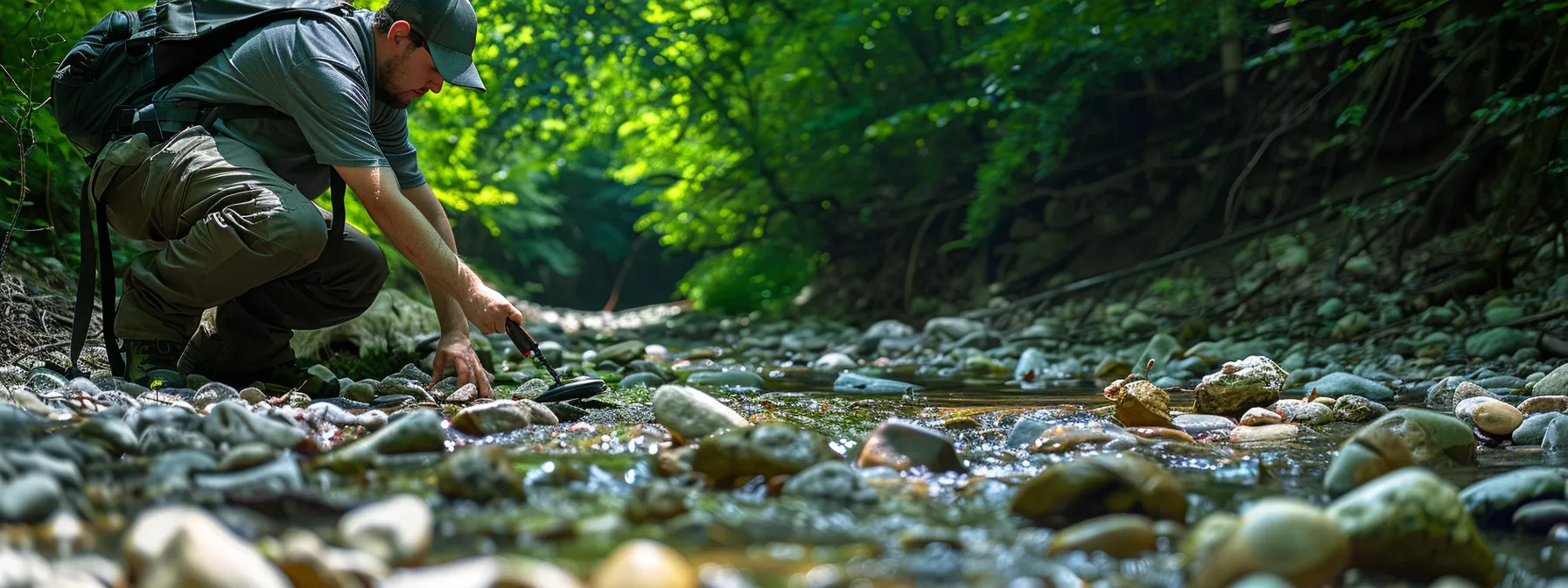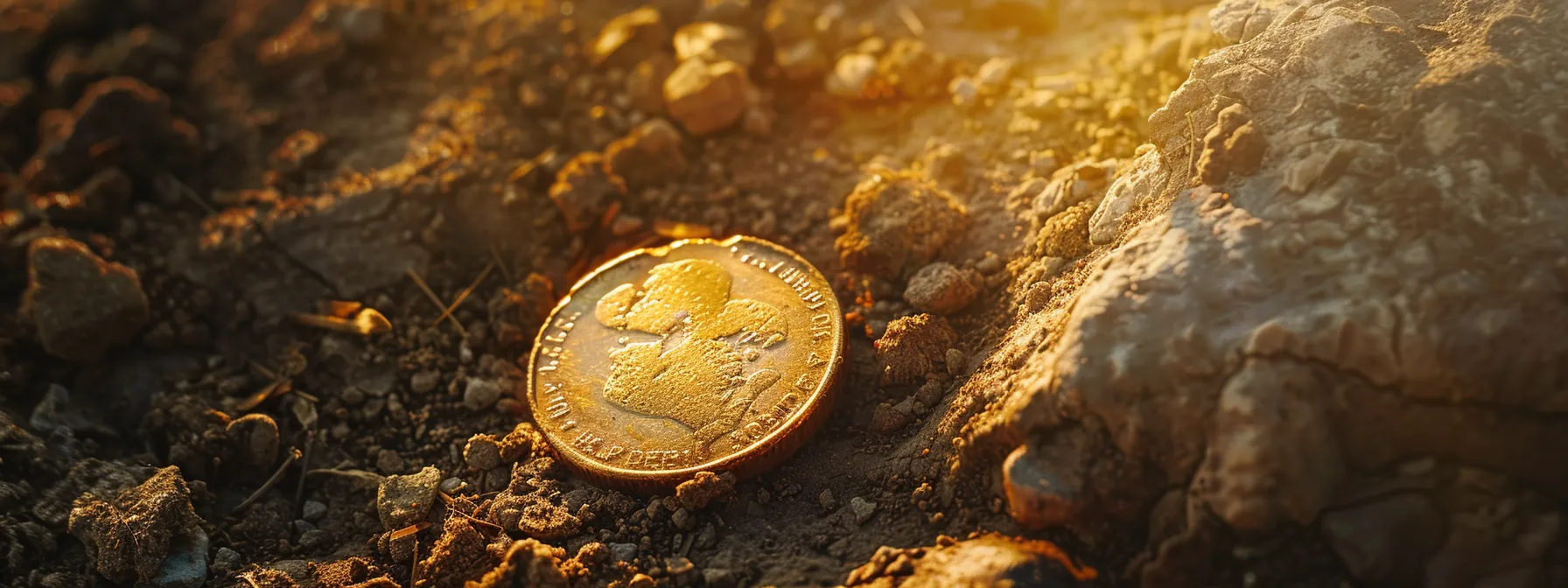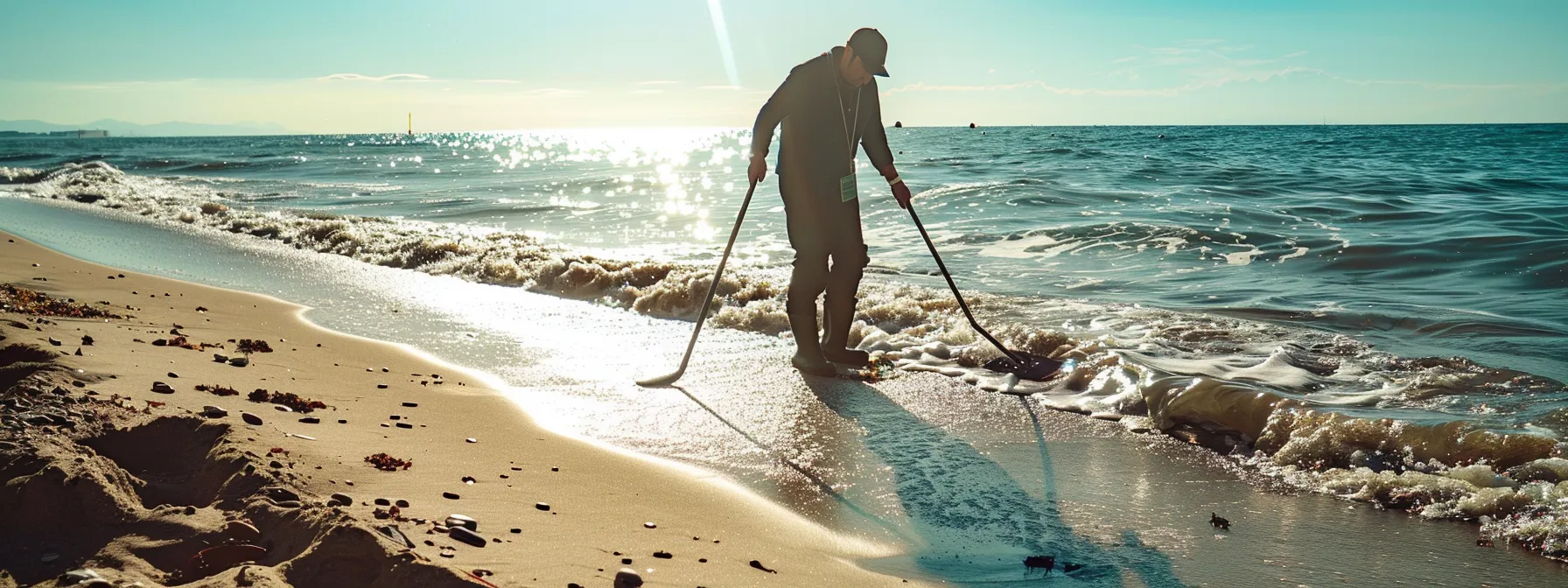

Metal detecting in streams can be an exciting way to uncover hidden treasures, but it also comes with its own set of hazards. Did you know that many accidents in this hobby occur due to unexpected floods or slippery conditions? In this guide, I’ll provide essential safety guidelines for stream metal detecting, covering everything from planning your trip and choosing the right equipment to recognizing potential environmental hazards. By following these tips, you’ll reduce your risk of emergency situations and enhance your overall experience in the water.
Key Takeaways
- Stay aware of environmental hazards like slippery surfaces, unstable ground, and wildlife encounters
- Always wear appropriate protective clothing and use quality gear for safety and comfort
- Research the area for legal requirements, local regulations, and access points before detecting
- Respect ecosystems by avoiding disruption and removing trash during your metal detecting outings
- Report significant historical finds to local authorities to contribute to preserving our shared heritage
Understanding the Risks of Stream Metal Detecting

In stream metal detecting, it’s crucial to be aware of various risks to ensure a safe and successful outing. I focus on recognizing common hazards like unstable ground and slippery surfaces. I also stay alert to changes in water depth and currents from Metal Detector Resources, protect myself from sudden weather shifts, and remain cautious of wildlife and plant dangers. This awareness enhances my archaeology adventures while minimizing the potential for accidents.
Identify Common Hazards in Stream Environments
When I head out for stream metal detecting, I always keep an eye out for common hazards that can pose risks. Wildlife can be unpredictable; I’ve encountered everything from snakes to curious insects, so it’s wise to stay alert. Additionally, navigating around rocky Metal Detecting Campsites and slippery banks is essential, especially when using tools like a shovel. Dredging can disturb the environment, altering water depth and flow, which adds another layer of caution. Understanding these factors helps me stay safe and focused on finding treasures.
Recognize Signs of Unstable Ground and Slippery Surfaces
When I’m out stream metal detecting, I always look for signs of unstable ground and slippery surfaces, as these can lead to accidents. Erosion often creates uneven ground, making it harder to walk safely near the water. I also consider accessibility; if a spot looks too steep or covered in loose rocks, LootDetective.com, Beach metal detecting tips is best to find a different area to ensure I can move easily and safely while detecting.
- Stay mindful of erosion around the banks.
- Choose accessible areas with stable footing.
- Avoid steep slopes that may lead to slips.
Stay Alert to Changes in Water Depth and Currents
As I venture into stream metal detecting, one of my top priorities is staying alert to changes in water depth and currents. Water levels can fluctuate quickly, especially during periods of rain or snowmelt, and I’ve learned to monitor the surrounding soil and mud for signs of rising water. Navigating a familiar trail can become hazardous if the stream unexpectedly swells, so I always verify my footing and assess the water flow before proceeding, ensuring I can move safely while hunting for buried treasures.
Protect Against Sudden Weather Changes
While I enjoy stream metal detecting, sudden weather changes can create unexpected risks that could impact my safety. For instance, heavy rain can result in rapidly rising water levels, transforming a manageable stream into a challenging environment. I always check the weather forecast before heading out and carry appropriate gear to protect myself—this includes water-resistant clothing and a reliable weapon, like a sturdy walking stick, to help navigate slippery terrain. Understanding how weather affects behavior in stream environments allows me to remain vigilant and prepared, reducing the risk of accidents.
Be Aware of Wildlife and Plant Dangers
When I’m out metal detecting in stream environments, I always keep a sharp eye on both wildlife and plant dangers. This means being aware of potential encounters with snakes and other animals that might be hiding near the water. I also watch out for plants that can cause skin irritation, like poison ivy, which can ruin a trip. Understanding the local wildlife rules and regulations is essential, especially if the law requires specific distance from nesting areas or seasonal restrictions. Additionally, I remember that navigating through snow can obscure hazards, so I take extra care during winter outings to ensure my safety.
- Be aware of hidden hazards from wildlife.
- Know which plants to avoid, such as poison ivy.
- Understand local wildlife laws and regulations.
- Exercise caution when detecting in snow-covered areas.
Stream metal detecting can be thrilling, but safety is key. Let’s explore the essential equipment that will help you stay safe while you search.
Essential Equipment for Safe Stream Metal Detecting

To ensure a safe and enjoyable stream metal detecting experience, I prioritize essential equipment. This includes selecting a waterproof metal detector specifically designed for stream environments. Wearing protective clothing and utilizing proper footwear can prevent accidents on wet and uneven terrain. Additionally, carrying safety accessories and emergency supplies prepares me for any situation. I always check that all my equipment is in good working order before I head out, enhancing my safety while hunting at some of the best places to metal detect. Let’s dive into the specifics of each category to help you stay safe on your adventures.
Select a Waterproof Metal Detector Suitable for Streams
When selecting a waterproof metal detector for stream metal detecting, I’ve found that not all detectors are created equal. It’s important to choose one that’s specifically designed for water environments to ensure effective detection while staying safe. You can check out sites like TreasureNet Forums and Blog Resources focused on metal detecting tips to compare reviews and find the Best Metal Detector suited for your needs. Remember, a reliable waterproof detector also aids in beach metal detecting, broadening your options for treasure hunting adventures at campsites and beyond.
Wear Protective Clothing and Gear
When I head out for stream metal detecting, I always wear protective clothing and gear to ensure my safety and comfort. Waterproof boots with good traction are crucial for navigating slippery rocks and uneven surfaces, which prevents slips and falls. Additionally, I opt for water-resistant clothing that can keep me dry while allowing flexibility for movement. By investing in suitable protective gear, I can focus on my treasure hunt without worrying about potential hazards, and resources from metal detector communities have provided valuable insights into the best options available for our needs.
Utilize Proper Footwear for Wet and Uneven Terrain
Utilizing proper footwear is essential for a successful outing in stream metal detecting. I always opt for waterproof boots with strong traction to navigate slippery rocks and uneven surfaces safely. This choice not only enhances my stability but also keeps my feet dry, allowing me to focus on my treasure hunt without the distraction of discomfort or potential slips.
Carry Safety Accessories and Emergency Supplies
Carrying safety accessories and emergency supplies is a vital part of stream metal detecting. I always pack a first aid kit, which is essential for treating minor injuries that could occur from slips or encounters with sharp objects. Additionally, having a whistle and a flashlight can be incredibly helpful in case I need assistance or if my outing extends into the evening, ensuring that I stay safe and visible while searching for treasures in the water.
Ensure All Equipment Is in Good Working Order
Before I embark on any stream metal detecting adventure, I always ensure that all my equipment is in good working order. This means checking my waterproof metal detector for battery life and functionality, inspecting my digging tools for damage, and verifying that my safety gear is intact. A small oversight could lead to significant disruptions during my treasure hunt, so I make it a habit to do these checks ahead of time to keep my experience smooth and enjoyable.
With your gear in hand, it’s time to think ahead. Planning your trip will lead you to the best spots and ensure a successful hunt.
Planning Your Stream Metal Detecting Trip

Before I head out for stream metal detecting, I make sure to research the area thoroughly to understand the terrain and any potential hazards. Informing someone of my itinerary and expected return is crucial for my safety. I always check the weather forecasts and stream conditions, prepare a comprehensive gear and safety checklist, and familiarize myself with access points and exit strategies. These steps ensure that I’m well-prepared for a successful outing.
Research the Area Thoroughly Beforehand
Before heading out for stream metal detecting, I prioritize researching the area thoroughly to understand its specific characteristics and potential hazards. I often utilize online maps and local forums to gain insights about the terrain and water conditions, which can significantly impact my search for hidden treasures. Getting familiar with regulations and access points helps me plan my route effectively and ensures that I’m well-prepared for any unforeseen challenges during my outing.
Inform Someone of Your Itinerary and Expected Return
Before heading out for my stream metal detecting trip, I always make it a point to inform someone about my itinerary and expected return. This simple step can be crucial in case of an emergency or if something goes wrong during my outing. By sharing my plan, I ensure that someone knows where I am and can take action if I fail to return on time, providing peace of mind for both myself and my loved ones.
Check Weather Forecasts and Stream Conditions
Before I set out for stream metal detecting, I always check the weather forecasts and stream conditions closely. Heavy rain or snowmelt can cause sudden changes in water levels, making normally safe areas dangerous. By staying informed about potential weather shifts, I can plan my trip more effectively and choose safer times to explore the stream, ensuring a fruitful treasure hunt without unnecessary risks.
Prepare a Comprehensive Gear and Safety Checklist
To ensure a smooth and safe stream metal detecting trip, I always prepare a comprehensive gear and safety checklist before I head out. This checklist includes essentials like my waterproof metal detector, digging tools, protective clothing, and emergency supplies, ensuring that I have everything I need at hand. Additionally, I incorporate items such as a first aid kit and weather gear to help me be ready for any situation, allowing me to focus on enjoying my treasure hunt while staying safe and well-prepared.
Understand Access Points and Exit Strategies
Understanding access points and exit strategies is essential for a successful stream metal detecting trip. I always map out how I’ll enter and exit the area, ensuring I know the best routes to take. For instance, I look for trails that lead safely to the water and consider potential hazards that might complicate my return. By planning these details ahead of time, I not only enhance my safety but also make my treasure hunting experience smoother and more enjoyable.
As you stand on the bank, the water flows quietly, hiding what lies beneath. Knowing how to stay safe in the stream will keep your adventure rewarding and fun.
Safe Techniques for Metal Detecting in Streams

In stream metal detecting, employing safe techniques is vital for a successful and injury-free experience. I focus on using correct wading methods to maintain balance, practicing safe digging underwater, and handling finds with care to avoid injury. Additionally, navigating slippery rocks and managing my energy levels can prevent fatigue, ensuring I remain alert and effective throughout my treasure hunt.
Use Correct Wading Methods to Maintain Balance
When I wade into a stream for metal detecting, using correct wading methods is crucial for maintaining balance and preventing slips. I always try to stay slightly bent forward, keeping my center of gravity low, which helps me navigate uneven surfaces and shifting sediments more easily. Additionally, I use a sturdy walking stick to help stabilize myself on slippery rocks and keep my footing secure while detecting in flowing water.
Implement Safe Digging Practices Underwater
When I dig underwater while metal detecting, I always prioritize safety to avoid injuries and ensure an efficient treasure hunt. I use a sand scoop or trowel designed specifically for underwater use, allowing me to grip and sift through sediments without losing my balance. It’s essential to dig carefully, as rushing can lead to slips or injuries from sharp objects hidden beneath the surface:
- Utilize a sand scoop or specialized trowel for better control.
- Maintain a steady position while digging to prevent slips.
- Be mindful of sharp objects that may be submerged.
Handle Finds Carefully to Avoid Injury
When I come across a promising find while metal detecting in streams, I always handle it with care to avoid injury. Sharp edges or hidden hazards can lurk on any item, especially when retrieving them from underwater settings. By taking my time and using tools like a grabber or gloves, I can safely assess my discoveries while minimizing the risk of cuts or punctures, allowing me to fully enjoy the treasure hunting experience without mishaps.
Navigate Slippery Rocks and Uneven Surfaces Safely
When navigating slippery rocks and uneven surfaces while stream metal detecting, I prioritize maintaining a steady stance. I often take smaller, deliberate steps, which helps me avoid losing my footing on wet or loose ground. Additionally, using a hiking stick or walking pole provides extra stability, allowing me to focus on detecting rather than worrying about slipping. This approach keeps me safe and enhances my overall treasure hunting experience.
Manage Energy Levels to Prevent Fatigue
Managing my energy levels during stream metal detecting is essential to prevent fatigue and maintain focus throughout the outing. I find it helpful to take regular breaks, staying hydrated, and fueling up with nutritious snacks to keep my stamina up. This practice allows me to enjoy longer detecting sessions and increases my chances of finding treasures while staying safe and alert:
- Take regular breaks to rest and recharge.
- Stay hydrated by drinking water consistently.
- Bring along snacks for quick energy boosts.
You’ve learned the best ways to search the streams safely. Now, let’s delve into how we can protect those waters and the environment while we hunt for treasure.
Environmental Responsibility While Detecting

Environmental Responsibility While Detecting
In stream metal detecting, I make it a priority to respect local ecosystems and habitats. This involves avoiding disruption to aquatic life and surrounding vegetation. It’s also crucial for me to remove any trash or debris I find while detecting. By following responsible outdoor recreation guidelines and educating others on environmental stewardship, I contribute to the community and preserve these natural spaces for future adventures.
Respect Local Ecosystems and Habitats
As I venture out for stream metal detecting, respecting local ecosystems and habitats is essential to me. I take care not to disturb aquatic life, including fish and invertebrates, by carefully navigating around their habitats. By practicing responsible metal detecting, like filling in any holes I dig and removing any trash I find, I help preserve these natural environments for future treasure hunters and ensure the beauty of our streams remains intact.
Avoid Disrupting Aquatic Life and Vegetation
When I’m out stream metal detecting, I make a conscious effort to avoid disrupting aquatic life and vegetation. This means being mindful of where I step, choosing paths that don’t disturb riverbanks or underwater habitats. For instance, I carefully navigate around plants and avoid areas where fish may be spawning, which helps maintain the delicate balance of the ecosystem while still allowing me to enjoy my hobby responsibly.
Remove Trash and Debris Found During Detection
When I metal detect in streams, I always make it a point to remove any trash and debris I find during my outings. Not only does picking up litter contribute to a healthier ecosystem, but it also enhances the overall experience for future treasure hunters. I encourage others to take the same approach by bringing extra bags for collecting trash, ensuring we leave the natural environment cleaner than we found it:
- Bring a designated bag for trash collection.
- Participate in local clean-up events to support conservation efforts.
- Educate fellow metal detectorists on the importance of leaving no trace.
Follow Guidelines for Responsible Outdoor Recreation
Following guidelines for responsible outdoor recreation is an essential part of stream metal detecting. I make it a practice to familiarize myself with local regulations and rules regarding protected areas before heading out. Respecting these guidelines not only enhances my treasure hunting experience but also protects the natural environment for future enthusiasts:
- Utilize designated paths to minimize ecological impact.
- Educate myself about seasonal restrictions for wildlife.
- Participate in conservation efforts within the detecting community.
Educate Others on Environmental Stewardship
One of the key aspects of responsible stream metal detecting is educating others on environmental stewardship. By sharing my experiences and knowledge with fellow enthusiasts, I foster a greater understanding of how our actions impact local ecosystems. I often engage in conversations about the importance of minimizing disruption to habitats and remind others to pick up trash they find while detecting, creating a culture of respect for nature in our community:
- Discuss the ecological impact of metal detecting with friends and fellow hunters.
- Share insights on best practices for preserving natural environments.
- Encourage participation in local clean-up events to promote conservation efforts.
Being mindful of our environment is just the beginning. Understanding the laws and ethics of metal detecting is essential to ensure we respect both land and legacy.
Legal and Ethical Considerations

Legal and Ethical Considerations
Before heading out for stream metal detecting, I always ensure I understand the legal and ethical landscape. This includes obtaining necessary permissions and permits, as well as familiarizing myself with local laws and regulations. I also respect private property boundaries and adhere to ethical metal detecting practices. If I come across significant historical finds, reporting them appropriately is essential. These considerations not only keep me within the law but also promote responsible treasure hunting.
Obtain Necessary Permissions and Permits
Before setting out for stream metal detecting, I always prioritize obtaining the necessary permissions and permits. This step is essential to ensure that I am following local laws and respecting private property rights. For example, I’ve found that many public parks and waterways have specific regulations regarding metal detecting, and checking these ahead of time can save me from potential legal issues and enhance my treasure hunting experience.
Understand Local Laws and Regulations
Understanding local laws and regulations is essential before I embark on any stream metal detecting adventure. Each area has specific rules that govern where and how I can detect, particularly regarding protected lands and historical artifacts. For instance, some states require permits for metal detecting in public parks, while others prohibit it altogether. By taking the time to research these regulations, I can avoid legal issues and ensure a respectful interaction with the environment and historical sites:
- Check for required permits before detecting.
- Respect restrictions on private property boundaries.
- Familiarize myself with local laws concerning historical finds.
Respect Private Property Boundaries
Respecting private property boundaries is crucial for maintaining a positive relationship with landowners and avoiding legal troubles during my stream metal detecting adventures. Before I venture onto any site, I make sure to seek permission if I suspect the land is privately owned. I’ve learned that clear communication with property owners can often lead to fruitful encounters and a more rewarding treasure hunting experience, as they may provide insights about the land’s history and previously found items.
Adhere to Ethical Metal Detecting Practices
Adhering to ethical metal detecting practices is crucial for maintaining the integrity of our hobby and ensuring a positive experience for everyone involved. I always make it a point to leave the environment as I found it, which includes filling in any holes I dig and removing any trash I encounter. By being respectful of historical sites and reporting significant finds, I not only follow ethical guidelines but also contribute to the preservation of our shared heritage, allowing future treasure hunters to enjoy the thrill of discovery as I do.
Report Significant Historical Finds Appropriately
When I come across a significant historical find while metal detecting in streams, it’s essential to report it appropriately. This includes notifying local archaeological organizations or state historical societies, as they can provide guidance on preserving such discoveries. I’ve learned that many of these finds, whether they are artifacts or coin hoards, can contribute to our understanding of history, and sharing them not only promotes responsible treasure hunting but can also lead to exciting opportunities for further research and collaboration with experts.
Conclusion
The “Comprehensive Guide to Safety Tips for Stream Metal Detecting” highlights the essential precautions that every enthusiast should take to ensure a safe and enjoyable experience. Staying aware of environmental hazards, utilizing appropriate gear, and respecting local ecosystems are crucial steps in preventing accidents and protecting nature. By planning thoroughly and prioritizing safety equipment, you can fully immerse yourself in the thrill of treasure hunting while minimizing risks. Remember, responsible and informed detecting not only enhances your adventures but also preserves opportunities for future enthusiasts.


